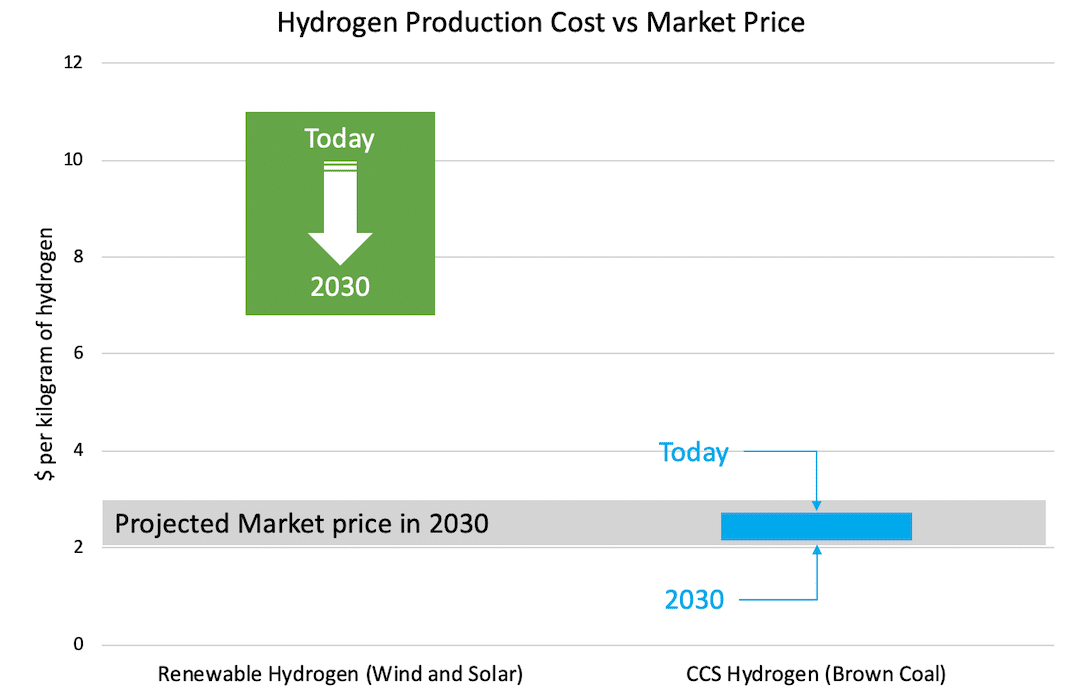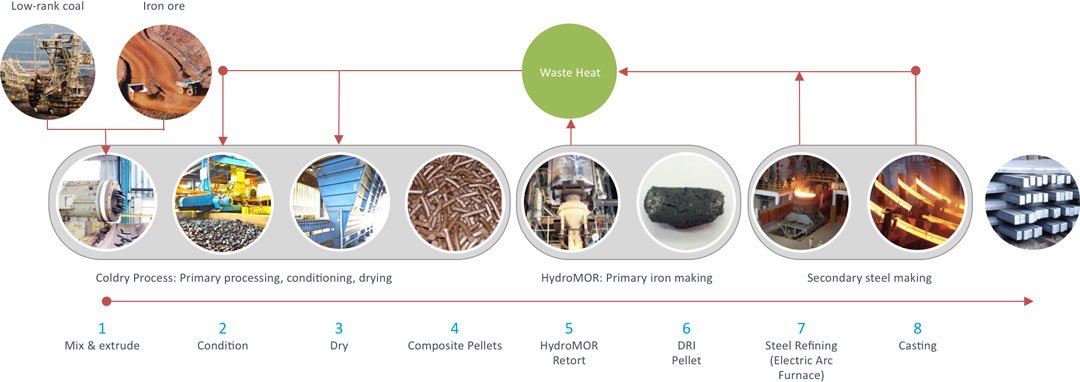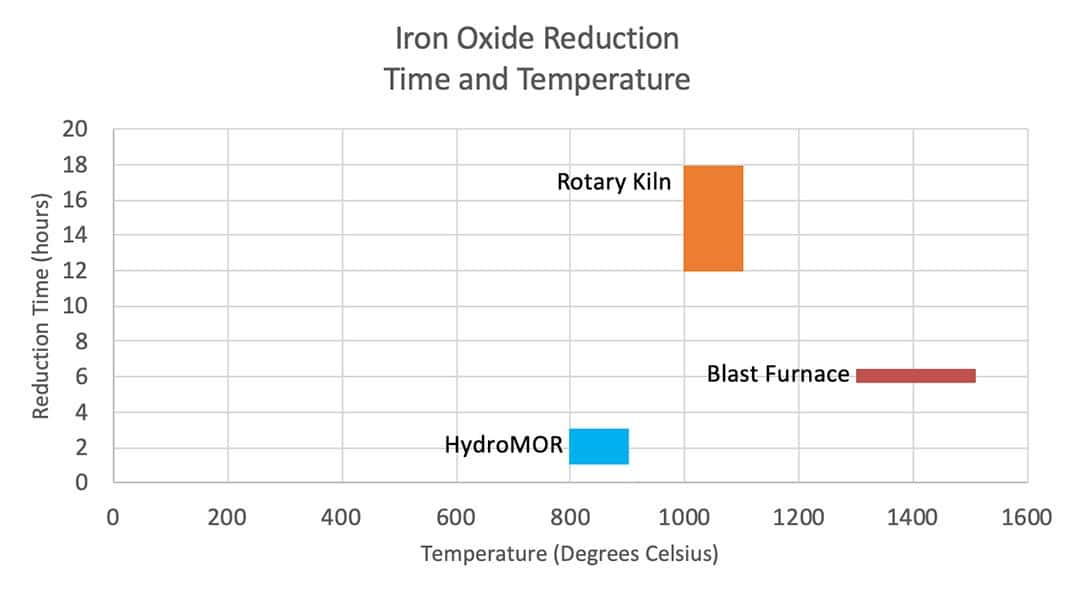Investor News
Can we make steel without metallurgical coal?
Well, yes, we can.
It's called HydroMOR, and it replaces expensive metallurgical coal with abundant, affordable lignite (brown coal), delivering lower emissions and, most importantly, lower cost.
This combination of lower emissions and lower cost is the key to successful innovation as we attempt to shift away from the use of metallurgical coal and, indeed, fossil fuels altogether.
At present, the ultimate solution is considered to be 'green' steel, made with renewable hydrogen. You see, carbon (in the form of carbon monoxide) is currently the dominant method of converting iron ore into iron. But hydrogen can also do the same job. Unfortunately, this route is more expensive. Green steel will eventually (probably) become economic, but the timeframe is decades from now.
This hasn't stopped some from taking the position that green alternatives for steelmaking are already available.
Over at 'The Conversation, ' an article by Dominique Hes, Senior Lecturer in Sustainable Architecture, University of Melbourne, argues this very point:
Just as thermal coal can be replaced with clean energy from renewables, we can use low-emissions steel manufacturing to phase out metallurgical coal.
The article is in response to the leader of the opposition, Anthony Albanese, confirming his belief that coking coal will still be required for steel making for decades, even if our thermal coal exports dwindle as coal-fired power is eventually phased out.
So, who is right?
The answer depends on the cost.
Before one can claim a solution is at hand, one needs to understand its techno-economic profile for a given set of market conditions.
A techno-economic feasibility study is required to determine both the technical suitability and the economic feasibility. Assuming it can do the job, is it cost-effective and competitive with alternatives in the context of local market conditions?
Unfortunately, discussion of economic performance when it comes to 'green' steel is usually omitted, as we previously mentioned here.
Just because something can (technically) be done doesn't mean it's economical. Some solutions may be economic in some circumstances and not in others due to locally available raw materials. For example, it makes economic sense to use natural gas in the Middle East, where natural gas is cheap and abundant, rather than import metallurgical coal.
In this respect, Hes is absolutely correct in the assertion that we can (technically) use low-emissions steelmaking methods to phase out metallurgical coal, but omits discussion of the most important factor required to make the shift; cost.
Think about it this way: solar-powered flight is now technically possible. They've even managed to circumnavigate the world on a solar-powered plane.
If we left the argument there, we'd be 100% correct that we can (technically) travel by solar-powered plane.
However, when you consider the economics, it's not a practical, affordable solution. It took 505 days (technical challenges, poor flying conditions, and a delicate aircraft all contributed to the slow pace) at an average speed of 70km an hour and could only carry two people. It is not economically feasible for solar power to replace fossil-fuel-powered passenger jets. The energy density of sunshine and battery storage is just too low to make them practical and affordable.
Now, we've previously performed a techno-economic feasibility study on our HydroMOR process, comparing it against the cost of the two current dominant primary steelmaking methods (blast furnace and DRI kiln).
It's the only way to know if our HydroMOR process is on track to deliver a lower-cost steelmaking solution.
The outcome?
HydroMOR is cheaper than both the blast furnace and the DRI kiln.

Note: The above summary is based on the techno-economic feasibility study for a 500,000 tonne per annum integrated steelmaking facility in India, utilising local iron ore fines and lignite
The important takeaway is that techno-economic feasibility studies provide a measure against which to make decisions.
A core skill for technology developers is learning to fail as quickly and cheaply as possible.
As a new idea advances from a prototype through the scale-up pathway from pilot to demonstration and eventual commercial deployment, techno-economic feasibility must be revisited at each point.
If our analysis indicated our HydroMOR technology was likely to cost more than the incumbent methods, we'd have to reconsider further investment in development.
With this approach in mind, let's look at the several technologies flagged by Hes as 'ready' to replace coking coal:
- Tyres: replacing coking coal with tyres and plastic in electric arc steelmaking
- Direct reduction:
- Midrex
- Energiron
- Renewable hydrogen: Hybrit
Rubber and plastic
This first approach doesn't deliver low-emissions steel so much as it displaces metallurgical coal with a source of carbon that may have ended up in a landfill.
Tyres can contain sulphur, zinc, and other additives that need to be considered to minimise any negative impact on the composition of the final steel product.
While additional refining can add time and cost, impacting economic feasibility, there appears to be insufficient publicly available data on the cost of using tyres in steelmaking, so it's difficult to comment further on the economics.
There is also a practical limitation to displacing metallurgical coal with tyres. Despite the huge number of tyres worldwide, there's not enough to completely replace metallurgical coal demand.
Globally, 1.5 billion tyres are discarded each year. Based on the local experience with rubber injection at the Arrium steel plant, 1 million car tyres offset 15,000 metric tonnes of coke.
Extrapolated, this theoretically displaces 22.5 million metric tonnes of coke (equivalent to around 33.75 million metric tonnes of metallurgical coal, as it takes about 1.5t metallurgical coal to make 1 tonne of coke).
For context, Australia currently supplies around 200 million of the world's 320 million metric tonnes of metallurgical coal.
Fully deployed, this tyre technology could shave up to 10% off metallurgical coal demand, which is great for reducing landfill but can't phase out metallurgical coal completely.
Direct Reduction
Direct reduction is an interim step towards zero-emissions steel making.
The two processes mentioned, Midrex and Energiron, are both in commercial operation.
Midrex can be configured to use coal, natural gas, or hydrogen. The pitch by Midrex is for end-users to establish a facility using natural gas, then move to 100% hydrogen when it becomes available and affordable.
Energiron is designed to take natural gas and crack it via a nickel catalyst to produce hydrogen and carbon monoxide, which are used to reduce iron ore to iron.
Both have lower CO2 footprints than a blast furnace.
HydroMOR is lower.
Sources: V G Lisienko et al 2016 IOP Conf. Ser.: Mater. Sci. Eng. 150 012023 & MN Dastur modelling of HydroMOR
The key takeaway: technology selection depends on a careful assessment of the available raw materials and the cost of production relative to alternative methods and materials.
In regions with abundant, low-cost natural gas, Midrex and Energiron should naturally be considered.
In regions with abundant, low-cost lignite, HydroMOR is a strong contender.
‘Direct reduction’ from renewable hydrogen
Direct reduction from renewable hydrogen is seen as the ultimate goal in the quest for zero-emission steel production.
Hes makes two distinct points in the article:
"The key message is this: it is possible to create low-emissions steel, without metallurgical coal. And it is already happening."
and
"... there’s no reason these fossil fuels can’t be entirely replaced with renewable hydrogen in the near future."
On the first claim, we agree with Hes. The use of natural gas by Energiron and Midrex are two examples. The use of lignite by HydroMOR is another (more on HydroMOR further down).
On the second claim, there is one consideration preventing the entire replacement of fossil fuels in the near future with renewable hydrogen: cost.
Unfortunately, nowhere in the article is the cost of renewable hydrogen mentioned. And given that cost is the single biggest factor that needs to be overcome when commercialising new technologies, especially in commodity markets like iron and steel, it should be front and centre in every discussion. Otherwise, how do we know what we're aiming for? How do we measure progress or success?
So let's briefly touch on the cost of renewable hydrogen:
- ‘Renewable hydrogen’ is made using electricity generated by wind turbines and solar panels
- According to BNEF, ‘green’ steel becomes economic when the cost of renewable hydrogen drops below USD2.20kg (AUD3.25kg) and metallurgical coal rises above USD310 per tonne (AUD435t), which they believe is possible by 2030
- The CSIRO's figures disagree with BNEF's, estimating that renewable hydrogen generation in Australia will drop in cost from AUD 11.00kg today to AUD 6.79kg by 2030 (chart below), while CCS hydrogen made from brown coal is already in the desired price range.

Source: Data from the National Hydrogen Roadmap - Pathways to an economically sustainable hydrogen industry in Australia, Bruce S, Temminghoff M, Hayward J, Schmidt E, Munnings C, Palfreyman D, Hartley P (2018) National Hydrogen Roadmap. CSIRO, Australia.
At the crux of the issue is energy density. Coal and natural gas are energy-dense, and the infrastructure required to harness that energy and convert it to hydrogen is relatively cost-effective and compact, even with carbon capture and storage (CCS).
Conversely, while sunshine and wind are free, they are extremely diffuse, and the infrastructure required to harness them to generate the electricity required to power the electrolysers to split water is relatively expensive and highly distributed.
Renewable hydrogen to supply green steel is absolutely technically possible, but steelmaker Arcelor Mittal has acknowledged that industrial scale-up is likely to take 10-20 years, and the cost of the steel is projected to be some 60 to 90 per cent higher than existing methods, calling into question not only the timeframes but fundamental economic feasibility.
Swedish steelmaker SSAB has embarked on a program to develop the ‘Hybrit’ process, as Hes mentions. SSAB's program aims to deliver a 1-2 tonne per hour pilot plant at the cost of AUD 210 million, then scale to commercial capacity by 2035 at an estimated cost of 20 to 30 per cent more per tonne of steel than existing methods.
To summarise, yes, it is absolutely technically possible to make steel with hydrogen made using electricity generated by wind and solar.
But, with all due respect to Hes, the high cost presents a good argument as to why this won't happen in the near future and certainly isn't ready to replace metallurgical coal today.
HydroMOR
What is possible today is our HydroMOR process.
HydroMOR is an alternative, lower-cost, hydrogen-driven, lignite-based iron-making process currently under development that can help bridge the gap between today’s CO2-intensive steelmaking methods and tomorrow's zero-emissions solutions.
HydroMOR achieves this through the clever use of lower-cost, abundant, alternative raw materials and an innovative chemical and process pathway.
By combining lignite (brown coal) with iron ore fines, we’re able to produce a composite pellet that enables the low temperature (<900C) reduction of iron ore, reducing capital and operating costs and CO2 emissions.
The pelletisation process is performed by our Coldry technology, efficiently removing most of the moisture from the lignite on the way through.

The composite pellets are charged to a proprietary furnace and heated.
This is where the ‘magic’ happens.
Unlike coking coal, lignite is rich in volatile matter consisting of organic hydrocarbons.
HydroMOR harnesses the natural chemistry of lignite, turning those hydrocarbons into gas, which is then 'cracked' to free the hydrogen, which reacts to strip away the oxygen from the iron ore, leaving pure iron (Fe). And because all this happens in situ from within the pellet, the process is relatively quick and efficient.
Uniquely, HydroMO's ability to convert the iron ore to iron via an in-situ hydrogen reaction, eliminates the need for external hydrogen generation or storage, creating a direct reduced iron pellet, pictured below.

The resulting gases heat the process, which is designed to be self-sustaining in most cases. Waste heat from the furnace is harnessed to provide drying energy for the COLDry stage.
Further, HydroMOR achieves reduction at a lower temperature than the blast furnace or rotary kiln routes and in significantly shorter timeframes.

HydroMOR can also process iron ore fines or mill scale, which are considered lower-value than premium lump iron ore and often considered waste.
So, steel can be made without metallurgical coal.
And green steel made from renewable-generated hydrogen may one day be affordable.
Until then, lower-cost innovations such as HydroMOR can help bridge the gap between today's use of metallurgical coal and tomorrow's hydrogen future.